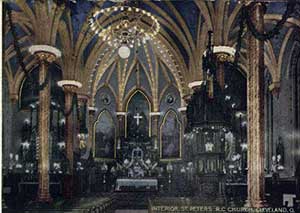German Americans of Cleveland
Cleveland Press Articles
Decade Marked by German Cultural Growth
"100 Years of Nationalities in Cleveland"
Twelfth of a Series
By Theodore Andrica
Cleveland Press, date unknown
The "bruderkampt" or conflict over the slavery issue between the older German settlers and the newer ones living in Cleveland and Ohio City (today's West Side) in the 1850-60 decade, did not diminish their zeal in creating worthwhile institutions.
Among the Cleveland Germans accomplishments in that decade were the establishment of the first three German Catholic churches; the founding of three Protestant congregations, in addition to the four already existing then, and the holding of the second national Saengerfest in 1859.
On the more worldly side of the ledger can be put the beginning of the first German theater in Cleveland in 1856.
The three German Catholic churches were St. Peter's, St. Mary's of the Assumption (West Side) and St. Joseph's.
The three new Protestant congregations established in the 1850-60 decade were: Trinity Evangelical Lutheran Church (1853), the West Side United Evangelical Protest Church (1853), and St. Paul's Evangelical Protestant Church (1858).
The four Protestant German churches established before 1850 were Schifflein Chmt Evangelical (1835), Zion Lutheran (1843), the First German Methodist (1845) and St. Luke's Evangelical Church (1846).
One of the first monuments in the history of German Catholicism in Cleveland is St. Peter's, the oldest German church here.
It should be noted here that from October, 1840 to Nov. 6, 1842, St. Mary's in the Flats, at Columbus and Girard streets, was the only Catholic church in Cleveland. On the last named date the second Catholic church was dedicated at Superior and Erie (now E. 9th street), the present site of St. John's Cathedral.
As the number of German Catholics increased in Cleveland, the Rev. Fr. John H. Luhr was brought from Canton to administer to those who frequented St. Mary's in the Flats Church.

Oldest German Catholic church in Cleveland is St. Peter's, Superior Ave. & E.17th St. It was erected in 1859.
Bishop Rappe authorized Father Luhr to organize a purely German Catholic parish. The new priest did so and on Feb. 13, 1853 St. Peter's Catholic German Parish was formed. The following spring in 1864, a lot was bought at Superior Ave. and Dodge St. (now E. 17th).
First a frame building was erected and later, in 1856, a two story brick structure was built to serve as a school and chapel. Finally, on Oct 3, 1859 the present St. Peter's was dedicated by Bishop Rappe.
In the meantime the West Side Germans, led by the Rev. Fr. J. J. Kraemer, organized in 1854 a parish of their own, naming it "St. Mary's of the Assumption." For a while the parish used the older St. Mary's Church in the flats. Under the pastorate of Rev. Fr. Stephen Falk the parish bought a lot at Jersey and Carol1 Sts. And construction of a new church began in September, 1863. it was dedicated on Sept. 13, 1865.
The beginning of St. Joseph's Church, Woodland and E. 23d St., goes back to 1855. St. Peters German Catholic parish established a small parochial school, named St. Bernhardt's, east of Irving St. In 1857 this frame combination school and church was moved to the southwest corner of Orange and Irving St.
In the summer of 1862 members of St. Bernhardt's mission were permitted to organize a parish of their own, with the Rev. Fr. Anton Krasney as first pastor. A larger lot was bought at Woodland and Chapel Aves. Another frame edifice was erected and the parish was re-named St. Joseph's.
At the invitation of Bishop Rappe a group of Franciscans took over the parish on Feb. 13, 1868. Under the leadership of Fathers Capistran Zwinge and Dominicus Droessler plans were made for the erection of a larger brick church, monastery and school.
The present church building was dedicated on Oct. 5, 1873.



